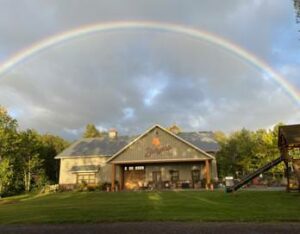Longtime banker Steve Burgess was sitting up in a tree waiting on a deer when he noticed something familiar about his hunting grounds: The 80-acre woodland within the city limits of Duluth, Minn., which he’d purchased after taking the top job at Superior, Wis.-based National Bank of Commerce, was thick with maple trees. Because experienced bankers are adept at recognizing potential, Burgess called his wife.
With her husband on the phone talking trees, Kathy Burgess was carried back to a time when their children were young and maple syruping had become a fun family hobby. But their children were grown and off raising children of their own, and the Burgesses were approaching the age when people typically recoil from big ideas.

Steve told Kathy he thought the land probably had 2,000 maples, mostly red maples with a smattering of sugar maples and silver maples. Kathy listened, wrapping herself in the armor of resistance. “I knew what he meant,” she said.
Renewing a passion
Steve Burgess had been a farm kid whose grandfather operated a business selling certified seed corn. Growing up, Burgess loved the land; he wanted to become an agricultural educator, but an internship introduced him to the world of agricultural credit, so he made the shift to banking. He contributed to the success of four Wisconsin banks across a four-decade career and then retirement came into view. Retirement not as an end but as a beginning, a chance to build something new by returning to something beloved.
Burgess Family Sugarhouse, branded to reflect their family’s history, right down to the seed business’s script font on their label, is built right on that Duluth woodland. The venture was formalized roughly five years ago and is licensed through the Minnesota Department of Agriculture, a milestone that was important to Steve. “We wanted licensing so we can branch into other products,” he said. “We feel our facility meets those standards and we’re pretty proud of it.”
Deciding between syruping as a hobby versus a business came down to viability. “We had the ability to tap all 2,000 trees,” Steve said. “It grew faster than we expected.”
The syrup produced at Burgess Family Sugarhouse is considered premium grade, sweeter than competitors while requiring less sap. “People like the taste and the quality,” Steve said.
All his years spent in banking helped Steve navigate the myriad factors that went into product pricing. “We have to make sure the cash flow works,” he said.
The process for making maple syrup deployed by the Burgesses bears little resemblance to the process used during their hobbyist days. Back then, sap dripped into plastic buckets and the Burgess children poured the sap into milk cans; when the cook started, the children kept a wood fire blazing under an evaporator pan while doing their schoolwork.
“In those days, we boiled down 70 to 80 gallons of sap a day,” Steve explained. “Now we might be boiling 2,000 gallons a day.” The rule of thumb for maple syrup production is 40 gallons of sap equals one gallon of syrup. In their modern operation, the evaporator is run on fuel oil and a reverse osmosis process accelerates removal of excess water. Bottling is done on premises.
Efficiencies were also gained by dumping the plastic buckets; these days, all the trees are linked by plastic tubing that can be remotely monitored for breakage, freeze-ups or, all too frequently, interference from curious or clumsy wildlife. Snowfall is also an obstacle to surmount, in most years.
In a typical season, the taps and tubes are installed in mid-winter and the sap starts to run at the beginning of March. And “run” is the correct verb, with 800 to 900 gallons of sap moving through the tubes per hour.
Burgess fires up the processing equipment once he has at least 1,000 gallons of sap stored.

In one season, the Burgesses will cook sap about 16 times. A season’s “crop” equals roughly 25,000 gallons of maple syrup, which is sold onsite, through area restaurants and coffee shops, or via their online store. The family also produces maple sugar and Kathy is working to perfect recipes for value-added products such as maple candy and maple cream.
Their syrup production has increased every year but one. In 2023, northern Minnesota’s record snowfall negatively impacted, well, everything.
Steve officially retired from National Bank of Commerce in 2023. Now, he spends most of his daylight hours working in the woods to prepare for the six-week-long season, running new lines each year, pounding in new taps, cooking sap, bottling syrup, then removing taps and lines so every process can begin anew. While the sap run brings a level of intensity to their late winter or early spring days, they consider their business a year-round operation.
The Burgess’s venture also has spawned businesses for two family members. Steve and Kathy’s son Lucas invented a multitool that simplifies the tapping and tubing process. The invention was the result of frustrations encountered on their property. “I told Lucas to quit complaining and do something about it,” Steve recounted. The multitool, marketed under the brand The Line Viper, is sold and used in syruping operations across North America.
The couple’s oldest grandson Caleb, 14, who Steve coached through the process of writing a business plan, buys his grandparents’ product at wholesale and has built a cottage enterprise selling syrup and maple-flavored products at the Owatonna, Minn., farmers market. “He’s done very well,” Kathy said.
The transition from business suits to snowshoes has been an easy one, Steve said. He enjoys talking to people about the process and their product. “The smiles and camaraderie with customers is really nice,” he said.
And, just like in banking, word of mouth always brings in new business.


